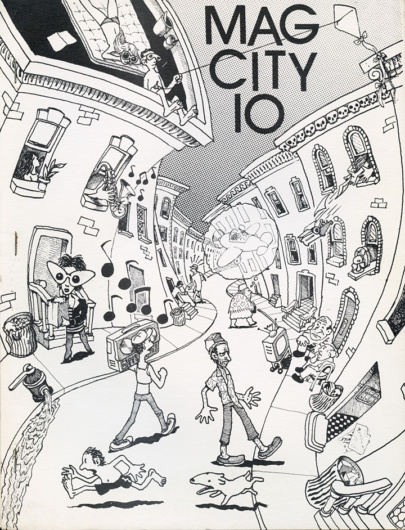Mag City
Gary Lenhart, Gregory Masters,
and Michael Scholnick
New York
Nos. 1–14 (1977–83).
Covers by David Borchard (10), Rudy Burckhardt (14), Louise Hamlin (9), Yvonne Jacquette (6), Alex Katz (14, back cover), Barry Kornbluh (2, 13), Rochelle Kraut (11), Steve Levine (4), George Schneeman (12), and Lee Sherry (3).
Mag City 10 (1980). Cover by David Borchard.

Mag City was a party in print. It was started to give a form to a literary scene that existed in the East Village, disenchanted with mainstream values. In the mid-’70s this neighborhood provided for a confluence of young artists, poets, musicians. The workshops led by Ted Berrigan and Alice Notley at The Poetry Project at St. Mark’s Church were where the third generation of New York School poets began to develop. Everyone attended the Monday and Wednesday night readings at the Project and would then convene in various bars afterward—Les Mykta, Grassroots, Orchidia, El Centro. Most of the poets worked part-time jobs or worked a few months and took off a few months. We wanted to be ready for the poem. We lived for poetry and were grateful to have discovered there were others like us out there whose priorities were complementary.

Mag City 12 (1981). Cover by George Schneeman.
Michael Scholnick, Gary Lenhart, and I lived in a tenement on East 12th Street. Other poets had preceded us there. We had no heat or hot water for two very cold winters. We didn’t know to be outraged. We assumed that was part of our training for being poets. The three of us were together a lot and we went to The Poetry Project and the Nuyorican Poets Cafe in its early days on East Sixth Street. Michael had had Miguel Algarín as a teacher at Rutgers so we were welcomed there and encouraged to get up and read our poems. The tradition of small press publishing emboldened us to publish our poems ourselves. But by the time we got Mag City going in 1977, offset printing was cheap enough and then the Xerox copier became available. Michael came up with the name and we asked our comrades for their poems. From the beginning our idea was to publish hefty chunks of work, as no other magazines were doing that.
At a typical meeting, we’d read each poem aloud and come to a consensus. There were never any arguments. If one of us believed strongly enough in a work, the others usually trusted enough to defer. We usually drew from the locals and then sent off letters to others whose work we admired. Sometimes we received material from as far away as China, where our friend Simon Schuchat was sojourning. We were honored to also publish Allen Ginsberg, Edwin Denby, Rudy Burckhardt, Ted Berrigan, Alice Notley, Ed Sanders, James Schuyler, Ron Padgett, and Bonnie Bremser in our pages. Publishing precedents were Lewis Warsh and Anne Waldman’s Angel Hair Press, Ted Berrigan’s “C” Press, Ed Sanders’s Fuck You/ a magazine of the arts, Larry Fagin’s Adventures in Poetry, and Lewis Warsh and Bernadette Mayer’s United Artists magazine and books.
Among our friends, Simon Schuchat’s 432 Review, Eileen Myles’s dodgems and the one-shot Ladies Museum, Elinor Nauen, Maggie Dubris, and Rachel Walling’s KOFF magazine, Jeff Wright’s Hard Press poetry postcard series, Tom Savage’s Gandhabba, Tom Weigel’s Tangerine magazine and anthologies, served up similar delights. The work printed in the fourteen issues of Mag City is too diverse to classify. It’s mostly confessional and personal. The work is decidedly unacademic, meaning the poems’ emphasis is content, not form, leaving rough edges, all the more for impact. If the work wasn’t always politically engaged, it offered reactions and responses to the malaise in this company. We were weathering a decade of Republican leadership that was contemptuous of free expression, individual peculiarities, social justice, and fun. The poems were often chatty and attempted to be accessible and entertaining by discoursing in common speech. They celebrated the common, the daily, and the immediate.
—Greg Masters, New York City, November 1995

Mag City 4 (1978). Cover by Steve Levine.
